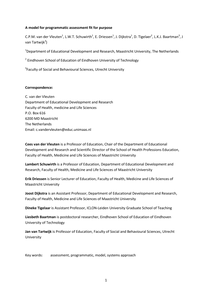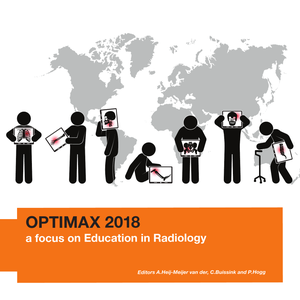The Co-Design Pressure Cooker was set up to gather knowledge on co-design in product development activities of Small-to-Medium Enterprises(SMEs). This booklet gives an impression of ten projects conducted in the Province of Utrecht, the Netherlands. In these ten projects, a total of 22 companies were involved. 5000 booklets have already been printed in Dutch and handed out to SMEs for knowledge dissemination. We have received ample requests from the international community, which leads us to believe that there is an international audience for the cases conducted and knowledge gathered. This is why we decided to publish an English version of this booklet. The booklet will be followed by a scientific publication on the knowledge gathered for the academic community. Feel free to contact us for more information on this project
DOCUMENT

from the Article: "Operating rooms (ORs) more and more evolve into high-tech environments with increasing pressure on finances, logistics, and a not be neglected impact on patient safety. Safe and cost-effective implementation of technological equipment in ORs is notoriously difficult to manage, specifically as generic implementation activities omit as hospitals have implemented local policies for implementations of technological equipment. )e purpose of this study is to identify success factors for effective implementations of new technologies and technological equipment in ORs, based on a systematic literature review. We accessed ten databases and reviewed included articles. )e search resulted in 1592 titles for review, and finally 37 articles were included in this review. We distinguish influencing factors and resulting factors based on the outcomes of this research. Six main categories of influencing factors on successful implementations of medical equipment in ORs were identified: “processes and activities,” “staff,” “communication,” “project management,” “technology,” and “training.” We identified a seventh category “performance” referring to resulting factors during implementations. We argue that aligning the identified influencing factors during implementation impacts the success, adaptation, and safe use of new technological equipment in the OR and thus the outcome of an implementation. The identified categories in literature are considered to be a baseline, to identify factors as elements of a generic holistic implementation model or protocol for new technological equipment in ORs."
MULTIFILE

Background: An effective and tolerable bowel preparation is important to secure quality of colonoscopies. It remains unclear if sodium picosulphate with magnesium citrate (SPMC), which is considered a tolerable bowel preparation agent, is also an effective alternative for polyethylene glycol (PEG) and sodium phosphate (NaP). Aim: The aim of this article is to compare effectiveness of SPMC to PEG and NaP through assessment of quality of bowel cleansing measured by validated tools. Methods: We searched electronic databases up to January 2015. Only randomised controlled trials (RCTs) were included. Two authors independently performed selection of studies, risk of bias assessment and data extraction. Results: Thirteen RCTs were included, with overall good quality, but large heterogeneity. SPMC had slightly better quality of bowel cleansing than PEG (pooled RR 1.06; 95% CI 1.02 to 1.11). In most trials SPMC was significantly better tolerated than PEG. There were no significant differences in effectiveness or tolerability between SPMC and NaP. Side effects were similar between agents, except for dizziness (pooled RR 1.71; 95% CI 1.32 to 2.21 in favour of PEG vs. SPMC) and vomiting (pooled RR 0.35; 95% CI 0.13 to 0.95 in favour of single-dose SPMC vs. split-dose). Conclusions: SPMC is equally effective to NaP and little superior to PEG in terms of bowel cleansing. SPMC preparations were better tolerated than PEG preparations. SPMC may be considered as standard bowel preparation for colonoscopy.
DOCUMENT
The consequences of head and neck cancer (HNC) treatment have great impact on patients' lives. Despite the importance of preparing patients for the period after discharge, patients frequently experience a lack of information. Aims of the study were to develop a nurse-led educational intervention to provide information during a discharge interview and to investigate the effects of the intervention on informational needs and satisfaction with information in HNC patients.
DOCUMENT

Aim Many long-term ostomates are ‘out-of-sight’ of healthcare, and it is unknown how ostomates deal with ostomy- related problems and how these problems affect their quality of life (QOL). The aim is to examine patient-related studies describing ostomy-related problems and their impact on the perceived QOL of long-term colostomates. Methods The electronic databases PubMed (MEDLINE), CINAHL, Cochrane Library and PsycINFO were systematically searched. All studies were included in which ostomy- specific QOL was measured using validated multidimensional instruments. Results Of the 6447 citations identified, 14 prevailingly descriptive cross-sectional studies were included. Three different validated multidimensional instruments for measuring QOL in ostomates were used (EORTC C30/CR38, MCOHQOLQO, Stoma QOL Questionnaire). All studies demonstrated that living with a colostomy influences the overall QOL negatively. The ostomy-related problems described included sexual problems, depressive feelings, gas, constipation, dissatisfaction with appearance, change in clothing, travel difficulties, feeling tired and worry about noises. Conclusion In conclusion, all 14 studies gave an indication of the impact of ostomy-related problems on the perceived QOL and demonstrated that a colostomy influences the QOL negatively. There is a wide range of ostomyspecific QOL scores, and there seem to be higher QOL scores in the studies where the MCOHQOLQO instrument was used. The MCOHQOLQO and the Stoma QOL Questionnaire gave the most detailed information about which ostomy-related problems were experienced. This review adds knowledge about the impact of stoma-related problems on QOL of long-term ostomates, but more research has to be conducted, to detect ostomy-related problems and especially possible care needs.
DOCUMENT

Study goal: This study was carried out to answer the following research question: which motivation do healthy volunteers have to participate in phase I clinical trials? - Methods: A literature search was done through Google Scholar and Academic Search Premier, followed by three interviews with volunteers who had recently concluded their participation in a (non-commercial) phase I trial. - Results: Our literature search revealed mainly commercial motives for volunteers to participate in phase I clinical trials. The interviews (with volunteers in a non-commercial trial) showed that other factors may also play a decisive role, such as: (1) wish to support the investigator (2) wish to contribute to science, (3) access to more/better health care (4) sociability: possibility to relax and to communicate with other participants (5) general curiosity. Precondition is that risks and burden are deemed acceptable. - Conclusions: financial remuneration appears to be the predominant motive to participate voluntarily in a clinical trial. Other reasons were also mentioned however, such as general curiosity, the drive to contribute to science and the willingness to help the investigator. In addition, social reasons were given such as possibility to relax and to meet other people. Potential subjects state that they adequately assess the (safety) risks of participating in a trial as part of their decision process.
DOCUMENT

A model for programmatic assessment in action is proposed that optimizes assessment for learning as well as decision making on learner progress. It is based on a set of assessment principles that are interpreted from empirical research. The model specifies cycles of training, assessment and learner support activities that are completed by intermediate and final moments of evaluation on aggregated data-points. Essential is that individual data-points are maximized for their learning and feedback value, whereas high stake decisions are based on the aggregation of many data-points. Expert judgment plays an important role in the program. Fundamental is the notion of sampling and bias reduction for dealing with subjectivity. Bias reduction is sought in procedural assessment strategies that are derived from qualitative research criteria. A number of challenges and opportunities are discussed around the proposed model. One of the virtues would be to move beyond the dominating psychometric discourse around individual instruments towards a systems approach of assessment design based on empirically grounded theory.
MULTIFILE

This year, OPTIMAX was warmly welcomed by University College Dublin. For the sixth time students and teachers from Europe, South Africa, South America and Canada have come together enthusiastically to do research in the Radiography domain. As in previous years, there were several research groups consisting of PhD-, MSc- and BSc students and tutors from the OPTIMAX partner Universities or on invitation by partner Universities. OPTIMAX 2018 was partly funded by the partner Universities and partly by the participants.
DOCUMENT

There is a wide range of literature suggesting that implicit learning is more effective than explicit learning when acquiring motor skills. However, the acquisition of nursing skills in educational settings continues to rely heavily on detailed protocols and explicit instructions. This study aimed to examine the necessity for comprehensive protocols in the acquisition of nursing skills. In the context of bandaging techniques, three studies were conducted to investigate whether students who practiced with an instruction card containing minimal instructions (implicit group) performed comparably to the students who practiced with a protocol containing step-by-step instructions (explicit group). Study 1 was designed to determine whether both groups performed equally well in applying a bandage during training. Study 2 and 3 were designed to determine if both groups performed equally well during a retention and transfer (multitasking) test, administered after a series of three training sessions. In comparison with the explicit group, the implicit group demonstrated comparable performance with their practice attempts in Study 1 and performed equally well during the retention and transfer test in Study 2. Furthermore, several results from Study 3 indicated better performance of the implicit group. In conclusion, the use of protocols with explicit step-by-step instructions may not be essential for the acquisition of nursing skills. Instead, instructional methods that facilitate implicit learning may be preferable, as students in the implicit group demonstrated at least comparable performance in all studies and tended towards greater consistency when multitasking.
DOCUMENT
